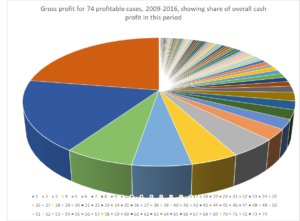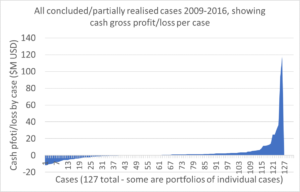Familiarity Breeds Success: Why Members of Congress Do Best When Buying Local Stocks
From 12/21/2010
Here’s an interesting article from BusinessWeek about how members of Congress do best when picking stocks from their own districts. While cynics will jump to the conclusion these representatives must be trading on inside knowledge gleaned from lobbyists, or just outright favoring local companies, I have to say I have a better record investing in New Jersey companies.
I was born and raised in New Jersey. I still live and work here. I know the place. And I do best when investing in New Jersey companies. At least half my best long-term investments were in New Jersey companies. It’s a small sample. But it’s a significant stat.
Also, I remember reading a paper in an academic journal, I’m going to say it was published sometime in the 1960s, that looked at brokerage accounts and found the two strongest predictors of good performance in any trade were the distance of the corporate headquarters from the investor’s home and the length of time the stock was held. The shorter the trade, the worse investors did. The closer the headquarters, the better investors did.
The combination of a local business held for a long time was often the investor’s best performing trade. That’s true for me. And it seems to be true for our elected representatives too.
It’s also how Phil Fisher got started investing.
Generally, it’s not a bad idea to read up on all the public companies in your home state. It might come in handy one day.
While I’m sure some folks will jump to the corruption angle, I totally disagree. There hasn’t been enough study of how familiarity affects investment performance. In my experience, familiarity turns otherwise mediocre traders into long-term value investors. Locals and insiders who otherwise aren’t value investors suddenly become very Buffett like when the business is down the street or they’re in the board room.
I’ve got a story about how being on the inside makes you a better investor.
I know a guy who used to work at Goldman Sachs (GS). Near the end of his career, he’d left Goldman and gone to work as the treasurer of a public company. It was a utility. Very easy to understand. Eventually the stock got cheap. And the dividend yield was obscene.
Now, this guy isn’t normally a good investor. He’s not terrible. He’s just not good. Not a real stock picker. Not going to dig into the 10-K of some obscure company. And definitely not a contrarian. He’ll buy some blue chips and some investment grade bonds. But he’s no value investor. And he’s no risk taker.
Day after day he sees the stock trading so low. He knows the dividend is covered. I should point out, that’s not because he’s the treasurer. This was a public company. It was a utility. Anyone could see the dividend was covered. Dividend coverage isn’t hard to calculate for a utility. Any outsider looking at the company knew the dividend was covered.
But

 Stephen Gamble, writer and analyst, 12th October 2019.
Stephen Gamble, writer and analyst, 12th October 2019.
